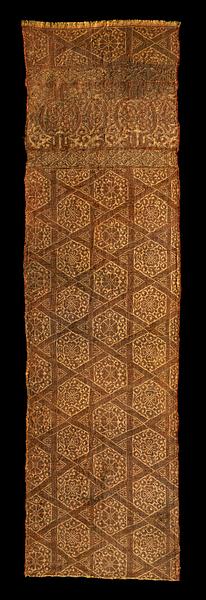Fragment of a lampas-woven textile, silk and gilded lamella of animal substrate both spun around a silk core and woven flat
Eastern Islamic area; mid-13th century
H: 113; W: 32 cm
Whereas geometric patterns in the Mongol/Il-Khanid period are often found on metalwork and ceramics, they are rarer on textiles.
The intertwined bands form a forceful pattern of hexagons that enclose stylized flowers. The pattern at the top is interrupted by a frieze with a highly stylized Arabic pseudo-inscription. Here the gilded lamella of animal substrate was woven flat, giving it a darker cast today.
In the geometric patterns, in contrast, the lamella was spun around a silk core in the sections that appear brownish today. When it was new, the fabric had a golden shine.
Inv. no. 14/1992
Published in:
Kjeld von Folsach and Anne-Marie Keblow Bernsted: Woven Treasures: Textiles from the World of Islam, The David Collection, Copenhagen 1993, cat. 16;
Kjeld von Folsach, Torben Lundbæk and Peder Mortensen (eds.): Sultan, Shah and Great Mughal: the history and culture of the Islamic world, The National Museum, Copenhagen 1996, cat. 254;
Kjeld von Folsach: Art from the World of Islam in The David Collection, Copenhagen 2001, cat. 637;
Sheila S. Blair and Jonathan M. Bloom (eds.): Cosmophilia. Islamic Art from the David Collection, Copenhagen, McMullen Museum of Art, Boston College, Boston 2006, cat. 63;
Kjeld von Folsach: “A set of silk panels from the Mongol period” in Sheila Blair and Jonathan Bloom (eds.): God is beautiful and loves beauty: the object in Islamic art and culture, New Haven 2013, p. 232, fig. 222a;
Eiren L. Shea: Mongol court dress, identity formation, and global exchange, Abingdon 2020, p. 31, note 137 and pl. 10;
Corinne Mühlemann: Complex weaves: technique, text, and cultural history of striped silks, Affalterbach 2023, fig. 20, p. 55;
